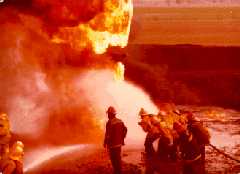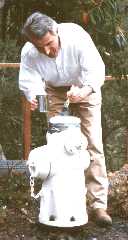Hydrant Color Codes and Markings; What They Mean
 Water is our most abundant and least expensive fire fighting agent. When fire companies arrive at a working fire, they need to be able to quickly determine which tactics they should employ and how best to supply themselves with water. There are several vital bits of information which we need.
Water is our most abundant and least expensive fire fighting agent. When fire companies arrive at a working fire, they need to be able to quickly determine which tactics they should employ and how best to supply themselves with water. There are several vital bits of information which we need.
 Primarily, we need to know how much water is available from the closest hydrant so that we may select the appropriate size hose lines for the size and complexity of the fire, but not select lines which would exceed the capacity of the hydrant and thus be ineffective. This information is known as "available flow."
Primarily, we need to know how much water is available from the closest hydrant so that we may select the appropriate size hose lines for the size and complexity of the fire, but not select lines which would exceed the capacity of the hydrant and thus be ineffective. This information is known as "available flow."
We also need to know the water pressure in each hydrant so that we can immediately implement the correct pumping operation at the supply hydrant. Water pressure is effected by elevation. The communities that we serve are spread over many elevations so pressures found in hydrants vary greatly. By knowing the pressure range in advance of connecting our hoses, we can implement the proper pumping operation and compensate for nearly every low pressure situation using the pumps in our fire engines.
nearly every low pressure situation using the pumps in our fire engines.
There are also a few other bits of information which are important to us, which are discussed below.
We have found the most efficient means to convey this important information to our engine companies is to paint the hydrant tops and caps using standardized color codes. These colors give us a reasonably accurate picture as to how the hydrant should perform. They are easy to recognize and as fire crews travel the streets performing their various duties, they see these hydrants and get a feel for where the problem areas exist well in advance of a fire alarm being called in.
Top Colors
We are located in a high risk urban-wildland intermix area. Our design criteria is for the water system to deliver no less than 2250 GPM from three nearby hydrants simultaneously flowing. We do not consider it a significant problem in those areas which have hydrants adequately placed throughout if an isolated hydrant here or there is an "orange top"... so long as it is surrounded by strong hydrants. It is in those locations where the abundance of the hydrants are weak that we are concerned with a fire rapidly building up beyond our ability to control it.
Due to the wide range of hydrant pressures that we experience, we also color code hydrants for pressure. These indicators are used primarily to streamline our operations. We don't need to tie up a fire engine pumping out of a high pressure fire hydrant, however with a low pressure hydrant, we need to position an extra engine at the hydrant to ensure maximum delivery of water to the fire engine operating at the scene. We have chosen to color code the outlet caps for this purpose to provide some consistency with our neighbor, the Oakland Fire Dept.
Outlet Cap Colors
Dead end mains don't just exist on dead end streets. Many roads which extend up into the hills cross multiple pressure zones and the water mains themselves will have "dead ends" at each point where one zone meets another.
NFPA standards require that private hydrants placed on or near public streets be painted a color that will distinguish them from public hydrants. Furthermore OSHA standards require sources of non-potable water be painted violet. We require that all hydrant bodies in our district reflect the responsible ownership and/or operation of the hydrant.
Introduction
 Water is our most abundant and least expensive fire fighting agent. When fire companies arrive at a working fire, they need to be able to quickly determine which tactics they should employ and how best to supply themselves with water. There are several vital bits of information which we need.
Water is our most abundant and least expensive fire fighting agent. When fire companies arrive at a working fire, they need to be able to quickly determine which tactics they should employ and how best to supply themselves with water. There are several vital bits of information which we need. Primarily, we need to know how much water is available from the closest hydrant so that we may select the appropriate size hose lines for the size and complexity of the fire, but not select lines which would exceed the capacity of the hydrant and thus be ineffective. This information is known as "available flow."
Primarily, we need to know how much water is available from the closest hydrant so that we may select the appropriate size hose lines for the size and complexity of the fire, but not select lines which would exceed the capacity of the hydrant and thus be ineffective. This information is known as "available flow."We also need to know the water pressure in each hydrant so that we can immediately implement the correct pumping operation at the supply hydrant. Water pressure is effected by elevation. The communities that we serve are spread over many elevations so pressures found in hydrants vary greatly. By knowing the pressure range in advance of connecting our hoses, we can implement the proper pumping operation and compensate for
 nearly every low pressure situation using the pumps in our fire engines.
nearly every low pressure situation using the pumps in our fire engines.There are also a few other bits of information which are important to us, which are discussed below.
We have found the most efficient means to convey this important information to our engine companies is to paint the hydrant tops and caps using standardized color codes. These colors give us a reasonably accurate picture as to how the hydrant should perform. They are easy to recognize and as fire crews travel the streets performing their various duties, they see these hydrants and get a feel for where the problem areas exist well in advance of a fire alarm being called in.
Top Colors
NFPA 291
| BLUE | 1500 GPM or more | Very good flows |
| GREEN | 1000-1499 GPM | Good for residential areas |
| ORANGE | 500-999 GPM | Marginally adequate |
| RED | Below 500 GPM | Inadequate |
Due to the wide range of hydrant pressures that we experience, we also color code hydrants for pressure. These indicators are used primarily to streamline our operations. We don't need to tie up a fire engine pumping out of a high pressure fire hydrant, however with a low pressure hydrant, we need to position an extra engine at the hydrant to ensure maximum delivery of water to the fire engine operating at the scene. We have chosen to color code the outlet caps for this purpose to provide some consistency with our neighbor, the Oakland Fire Dept.
Outlet Cap Colors
(Note: This is a local deviation from NFPA standards that recommend cap colors also indicate flow!)
| GREEN | Over 120 p.s.i | Extremely high pressure (caution!) |
| ORANGE | 50-120 p.s.i. | "Normal" pressure range |
| RED | Below 50 p.s.i. | Must be "pumped" |
Other Miscellaneous Markings
Dead End Water Mains
The important element surrounding "dead end" mains is that they are only supplied with water from one end. In such instances, fire companies pumping "upstream" from other companies can impact water supply to their "downstream" counterparts. By marking the hydrants and direction of water flow, our engine companies can be made aware of the situation and coordinate appropriately among themselves to ensure the available water is adequately shared.Dead end mains don't just exist on dead end streets. Many roads which extend up into the hills cross multiple pressure zones and the water mains themselves will have "dead ends" at each point where one zone meets another.
Regulated Mains
We also have some neighborhoods in very high pressure areas where the water mains themselves are fed through pressure regulators so that water supplied to domestic users is not so extreme that it could damage water meters and plumbing. In these instances it is of critical importance to shut fire hydrants down slowly in order to prevent damage to water mains and system regulator sets. The orange "R" in a circle is a warning to fire fighters that the hydrant is on a regulator supplied pressure zone.| Orange Arrow | -> | Indicates direction of water flow on a "dead end" main |
| Orange Arrow and vertical bar | ->| | Indicates last hydrant and direction of water flow on a "dead end" main |
| Orange "R" in a circle | ® | Indicates hydrant is on a regulated pressure zone |
Body Colors
| WHITE | Public System Hydrant | (EBMUD) |
| YELLOW | Private System Hydrant | Connected to public water main |
| RED | Special Operation Hydrant | Not used except for spcl. procedures |
| VIOLET | Non Potable Supply | Effuent, pond or lake supply |
Water District Markings
In addition to these fire department applied markings, one will notice Roman numerals and other indicators painted in red. These markings indicate the location of the street shutoff valve which would need to be accessed in order to shut down the hydrant in the event it was knocked off or supply needed to be shut down for repairs.
 5:58 AM
5:58 AM
 Kancil Jogja
Kancil Jogja

 Posted in:
Posted in: 
0 comments:
Post a Comment